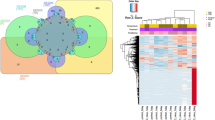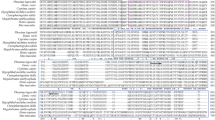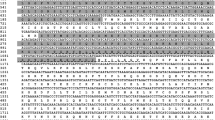Abstract
The hypoxia-inducible gene 1, YGHL1 from olive flounder (Paralichthys olivaceus) (fYGHL1) was cloned, and its structural organization and expression profiles were determined. A 1,400 kb full-length cDNA encoding a predicted polypeptide of 91 amino acids was sequenced. The fYGHL1 gene comprises three introns, four exons, and several transcriptional elements upstream of the transcriptional start site. The mRNA transcript is expressed in almost all tissues, with high expression in the intestine and brain of normal-conditioned fish, and is expressed constitutively in early developmental stages after hatching. The mRNA expression of fYGHL1 is highly regulated by hypoxia and E. tarda infection. The expression of fYGHL1 mRNA was down regulated in the gill, spleen, intestine, and stomach of flounder under hypoxic conditions, whereas the expression level was increased in flounder embryonic cells treated with the hypoxia-mimic CoCl2 (a HIF-1 inducer). Pathogen challenge induced fYGHL1 expression in the spleen of juvenile fish. Taken together, these results suggest that fYGHL1 is a hypoxia-related gene with potential roles in the hypoxia response mechanism as well as in defense, immune responses, growth, and regulation of reproduction.






Similar content being viewed by others
Abbreviations
- EST:
-
Expressed sequence tag
- BLAST:
-
Basic local alignment and search tool
- GAPDH:
-
Glyceraldehyde phosphate dehydrogenase
- SNPs:
-
Single nucleotide polymorphisms
- HIF:
-
Hypoxia-inducible factor
References
Diaz JR, Rosenberg R (1995) Marine benthic hypoxia: a review its ecological effects and the behavioural responses of benthic marcofauna. Oceanogra Mar Biol Annu Rev 33:245–303
Semenza GL (2000) HIF-1: mediator of physiological and pathophysiological responses to hypoxia. J Appl Physiol 88:1474–1480
Pihl L, Baden SP, Diaz RJ, Schaffener LC (1992) Hypoxia-induced structural changes in the diet of bottom-feeding fish and crustacea. Mar Biol 113:39–361
Peckol P, Rivers JS (1995) Physiological responses of the opportunistic macroalgae Cladophora vagabunda (L.) and Gracilaria tikvahiae (McLachlan) to environmental disturbances associated with eutrophications. J Exp Mar Biol Ecol 190:1–16
Sandberg E (1997) Does oxygen deficiency modify the functional responses of Saduria entomon (Isopoda) to Bathyporeia pilosa (Amphipoda). Mar Biol 729:499–504
Gesamp (1990) The State of the Marine Environment. UNEP Regional Sea reports and studies. No. 115. UNEP Blackwell Scientific Publications, Oxford
Goldberg ED (1995) Emerging problems in the coastal zone for the twenty-first century. Mar Pollut Bull 31:152–158
Wu RSS (1999) Eutrophication, trace organics and water-borne pathogens: pressing problems and challenge. Mari Pollut Bull 39:11–22
Baden SP, Loo LO, Pihl L, Rosenberg R (1990) Effects of eutrophication on benthic communities including fish: Swedish west coast. Ambio 19:113–122
Baden SP, Phil L, Rosenberg R (1990) Effects of oxygen depletion on the ecology, blood physiology and fishery of the Norway lobster Nephrops norvegicus. Mar Ecol Prog Ser 67:141–155
Lu L, Wu RSS (2000) An experimental study on recolonization and succession of marine macrobenthos in defaunated sediment. Mar Biol 136:291–302
Wu RSS (2002) Hypoxia: from molecular responses to ecosystem responses. Mar Pollut Bull 45:35–45
Nikinmaa M, Rees BB (2005) Oxygen-dependent gene expression in fishes. Am J Physiol Regul Integr Comp Physiol 288:1079–1090
Randall DJ, McKenzie DJ, Abrami G, Bondiolotti GP, Nayiello F, Bronzi P, Bolis L, Agradi E (1992) Effects of diet on responses to hypoxia in sturgeon (Acipenser naccarii). J Exp Biol 170:113–125
Hochachka PW (1997) Oxygen-A key regulatory metabolite in metabolic defense against hypoxia. Am Zool 37:595–603
Gracey AY, Troll JV, Somero GN (2001) Hypoxia-induced gene expression profiling in the euryoxic fish Gillichthys mirabilis. Proc Natl Acad Sci USA 98:1993–1998
Ton C, Stamatiou D, Liew CC (2003) Gene expression profile of zebrafish exposed to hypoxia during development. Physiol Genomics 13:97–106
Van der Meer DL, van den Thillart GE, Witter F, de Bakker MA, Besser J, Richardson MK, Spaink HP, Leito JK, Bagowski CP (2005) Gene expression profiling of the long-term adaptive response to hypoxia in the gills of adult zebrafish. Am J Physiol Regul Integr Comp Physiol 289:1512–1519
Padilla PA, Roth MB (2001) Oxygen deprivation causes suspended animation in the zebrafish embryo. Pro Natl Acad Sci USA 98:7331–7335
Semenza GL (1999) Regulation of mammalian O2 homeostasis by hypoxia-inducible factor 1. Annu Rev Cell Dev Biol 15:551–578
Thompson JD, Higgins DG, Gibson TJ (1994) CLUSTAL W: improving the sensitivity of progressive multiple sequence alignment through sequence weighting, position specific gap penalties and weight matrix choice. Nucleic Acid Res 22:4673–4680
Kumar S, Tamura K, Jakobsen IB, Nei M (2001) MEGA2: molecular evolutionary genetics analysis software. Bioinformatics 12:1244–1245
Saitou N, Nei M (1987) The neighbor-joining method: a new method for reconstructing phylogenetic trees. Mol Biol Evol 4:406–425
Kasai H, Yoshimizu M (2001) Establishment of two Japanese flounder embryo cell lines. Bull Fish Sci Hokkaido Univ 52:67–70
Du F, Zhu L, Qian ZM, Wu XM, Yung WH, Xu WY, Ke Y (2008) Expression of bystin in reactive astrocytes induced by ischemia/reperfusion and chemical hypoxia in vitro. Biochem Biophys Acta 1782:658–663
Choi JH, Cho HK, Choi YH, Cheng JH (2009) Activating transcription factor 2 increases transactivation and protein stability of hypoxia-inducible factor 1α in hepatocytes. Biochem J 424:285–296
Nam BH, Byon JY, Kim YO, Park EM, Cho YC, Cheong J (2007) Molecular cloning and characterization of flounder (Paralichthys olivaceus) interleukin-6 gene. Fish Shellfish Immunol 23:231–236
Aoki T, Naka H, Katagiri T, Hirono I (2000) Cloning and characterization of glyceraldehydes-3-phosphate dehydrogenase cDNA of Japanese flounder Paralichthys olivaceus. Fish Sci 66:737–742
Lee JH, Noh JK, Kim HC, Park CJ, Min BH, Kim YO, Kim JH, Kim KK, Kim WJ, Myeong JI (2009) EST-based identification of genes expressed in the brain of the olive flounder Paralichthys olivaceus. Fish Aqua Sci 18:286–292
Wang WR, Zhou YB, Liu F, Wang KS, Shen Y, Liu JH, Han ZG (2006) A novel recently evolved gene C19orf24 encodes a non-classical secreted protein. Cell Mol Biol Lett 11:161–170
Marchler-Bauer A, Anderson JB, Chistaz F, Derbyshire MK, DeWeese-Scott C, Fong JH, Geer LY, Geer RC, Gonzales NR, Gwadz M, He S, Hurwitz DI, Jackson JD, Ke Z, Lanczycki CJ, Liebert CA, Liu C, Lu F, Lu S, Marchler GH, Mullokandov M, Song JS, Tasneem A, Thanki N, Yamashita RA, Zhang D, Zhang N, Bryant SH (2009) CDD: specific functional annotation with the conserved domain database. Nucleic Acids Res 37:205–210
Yao YY, Barbara RD, Ghosh S, Fang Y, Leach RJ, Seto E (1998) Cloning, chromosomal localization and promoter analysis of the human transcription factor YY1. Nucleic Acids Res 26:3776–3783
Usheva A, Shenk T (1994) TATA-binding protein-independent initiation: YY1, TFIIB, and RNA polymerase II direct basal transcription on supercoiled template DNA. Cell 76:1115–1121
Szalad A, Katakowski M, Zheng X, Jiang F, Chopp M (2009) Transcription factor Sp1 induces ADAM17 and contributes to tumor cell invasiveness under hypoxia. J Exp Clin Cancer Res 28:129–137
Ferreira TC, Hertzberg L, Gassmann M, Campos EG (2007) The yeast genome may harbor hypoxia response elements (HRE). Comp Biochem Physiol C Toxicol Pharmacol 146:255–263
Chen SL, Xu MY, Hu SN, Li L (2004) Analysis of immune-relevent genes expressed in red sea bream (Chrysophrys major) spleen. Aquaculture 240:115–130
Nizet V, Johnson RS (2009) Interdependence of hypoxia and innate immune responses. Nat Rev Immunol 9:609–617
Acknowledgments
This study was supported by a grant from the National Fisheries Research and development Institute (NFRDI), Republic of Korea.
Author information
Authors and Affiliations
Corresponding author
Rights and permissions
About this article
Cite this article
Kim, YO., Park, EM., Moon, J.Y. et al. Molecular characterization and transcriptional analysis of the olive flounder (Paralichthys olivaceus) YGHL1 gene in response to hypoxia and infection. Mol Cell Biochem 357, 305–312 (2011). https://doi.org/10.1007/s11010-011-0901-7
Received:
Accepted:
Published:
Issue Date:
DOI: https://doi.org/10.1007/s11010-011-0901-7




